To elevate your mobile landscape photography to a pro level, focus on mastering composition techniques like the rule of thirds and leading lines. Optimize your camera settings by using manual mode and shooting in RAW format for maximum control and flexibility. Take advantage of natural light, especially during golden hours, to create stunning atmospheres. Don't be afraid to explore unique perspectives by getting low or finding high vantage points. Finally, edit your images thoughtfully using powerful mobile apps to enhance mood and impact. These five tips will set you on the path to capturing breathtaking landscapes with your smartphone. Dive deeper to reveal even more secrets of mobile landscape photography.
Master Composition Techniques
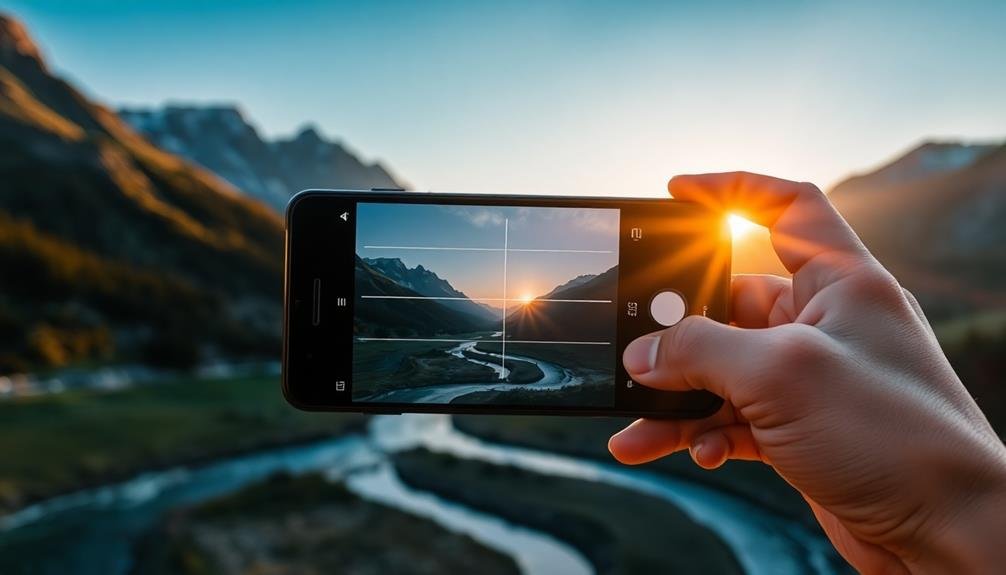
Composition mastery is the cornerstone of stunning mobile landscape photography. To elevate your shots, start by applying the rule of thirds. Divide your frame into a 3×3 grid and place key elements along these lines or at their intersections. This creates balance and draws the viewer's eye through the image.
Next, use leading lines to guide attention. Look for natural paths, roads, or rivers that lead into the scene, creating depth and perspective. Incorporate foreground elements to add dimensionality and anchor your shots. A rock, flower, or tree branch in the foreground can provide scale and context.
Don't forget about framing. Use natural elements like tree branches or archways to frame your subject, adding layers and focusing attention.
Play with symmetry and reflections, especially in water bodies, to create visually striking images. Experiment with different perspectives. Get low to the ground or find a high vantage point to offer unique views.
Optimize Camera Settings
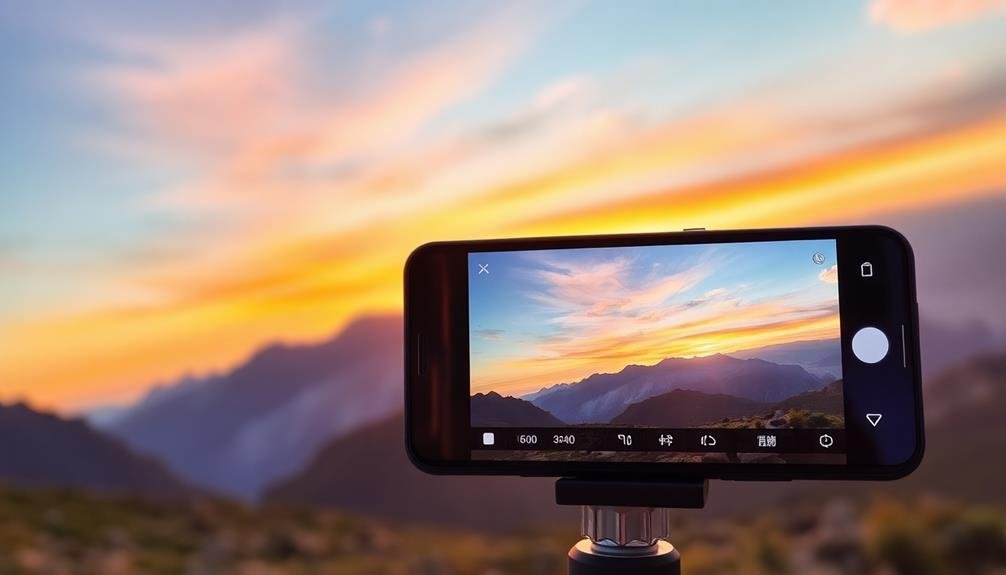
Your smartphone's camera is a powerful tool, but knowing how to optimize its settings is vital for capturing stunning landscape photos.
Start by enabling HDR (High Dynamic Range) mode to capture a wider range of tones in high-contrast scenes. This feature helps balance bright skies with darker foregrounds.
Next, switch to your phone's Pro or Manual mode for greater control. Adjust the ISO to the lowest possible setting to minimize noise in your images. For sharp landscapes, use a higher f-number (smaller aperture) to increase depth of field. If your phone allows, set the white balance manually to match the lighting conditions.
When shooting in low light, use a longer shutter speed to capture more detail. Stabilize your phone with a tripod or steady surface to avoid camera shake. For moving elements like water or clouds, experiment with even slower shutter speeds to create a sense of motion.
Don't forget to shoot in RAW format if your phone supports it. This preserves more image data, giving you greater flexibility when editing later.
Utilize Natural Light Effectively
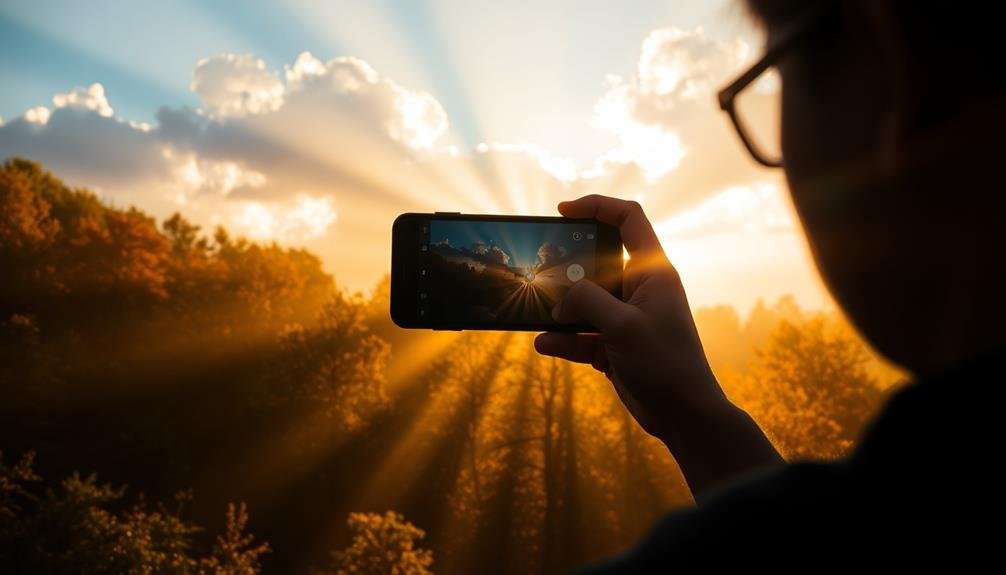
Natural light mastery is essential for capturing breathtaking landscape photos with your mobile device. Understanding how light affects your scenes at different times of day can elevate your images from amateur to professional quality. During the golden hours (just after sunrise and before sunset), you'll find warm, soft light that adds depth and dimension to your landscapes. Midday sun can create harsh shadows, but it's ideal for capturing vibrant colors in scenes with water or lush greenery.
To make the most of natural light, consider these techniques:
| Time of Day | Lighting Effect | Emotional Impact |
|---|---|---|
| Dawn | Soft, cool tones | Serene, hopeful |
| Sunrise | Warm, golden hues | Energizing, inspiring |
| Midday | Bright, harsh light | Stark, dramatic |
| Sunset | Rich, warm colors | Romantic, nostalgic |
| Twilight | Subtle, blue tones | Mysterious, calming |
Learn to use backlighting for silhouettes, side-lighting to emphasize textures, and front-lighting to showcase details. Don't shy away from overcast days; they provide even lighting that's perfect for capturing subtle color variations. Experiment with different angles and perspectives to see how light interacts with your subject, and you'll soon develop an intuitive sense of how to utilize natural light effectively in your mobile landscape photography.
Explore Unique Perspectives
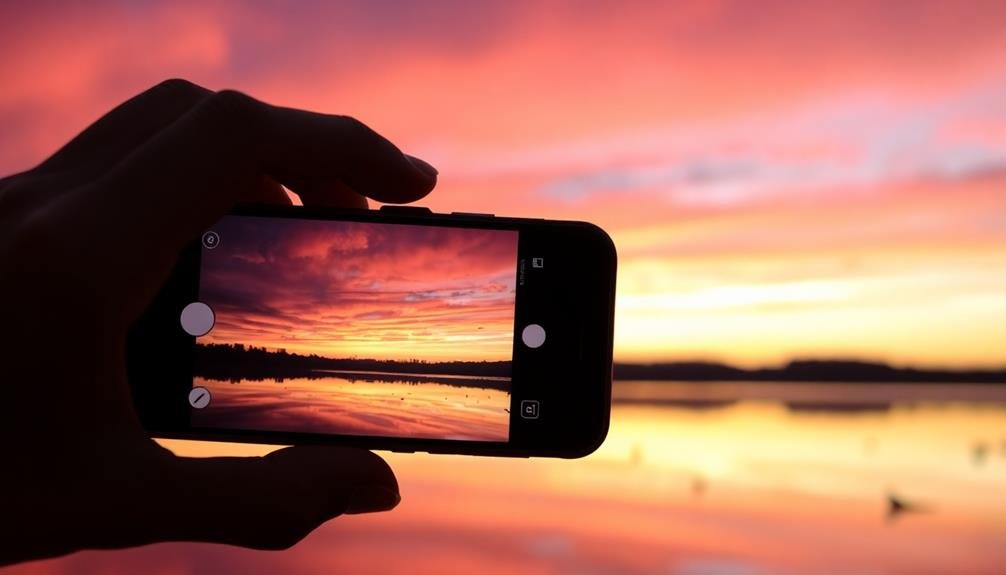
Discovering unique perspectives is key to creating enchanting landscape photos with your mobile device. Don't settle for eye-level shots that everyone else takes. Instead, challenge yourself to find fresh angles that'll make your images stand out.
Get low to the ground for a worm's eye view, or climb to a higher vantage point for a bird's eye perspective. These unconventional angles can add depth and interest to your compositions.
Experiment with framing techniques to guide the viewer's eye and create a sense of depth. Use natural elements like tree branches, rock formations, or architectural features to frame your subject.
Don't be afraid to break traditional composition rules; sometimes, an off-center or asymmetrical shot can be more visually appealing.
To help you explore unique perspectives, try these techniques:
- Use leading lines to draw the viewer's eye into the scene
- Incorporate reflections in water or glass for a mirror effect
- Experiment with extreme close-ups of natural textures
- Play with silhouettes against dramatic skies
Edit for Maximum Impact
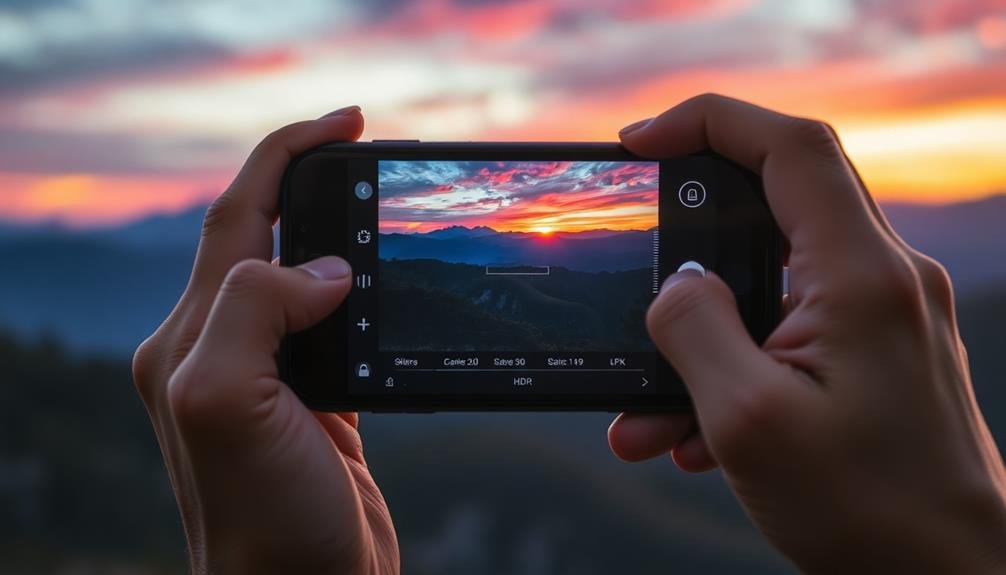
Although capturing a great shot is essential, editing can elevate your mobile landscape photography to the next level.
Start by selecting a powerful editing app like Snapseed, VSCO, or Lightroom Mobile. These tools offer professional-grade features that can transform your images.
Begin with basic adjustments: tweak the exposure, contrast, and saturation to enhance the overall look. Pay attention to the highlights and shadows, ensuring you retain detail in both bright and dark areas.
Use the clarity and structure sliders sparingly to add depth without making the image look artificial.
Next, focus on color grading. Adjust the white balance to set the right mood, and use selective color adjustments to make specific hues pop.
Don't shy away from using filters, but customize them to suit your style and the scene.
Finally, crop your image thoughtfully to improve composition. Remove distracting elements and emphasize the main subject.
Consider using the rule of thirds or leading lines to guide the viewer's eye.
Frequently Asked Questions
What Essential Gear Should I Carry for Mobile Landscape Photography?
You'll need your smartphone, a sturdy tripod, and a wide-angle lens attachment. Pack a power bank, cleaning cloth, and waterproof case. Don't forget a remote shutter release and a few filters for creative effects.
How Can I Protect My Phone From Extreme Weather Conditions?
You'll want to invest in a waterproof case to shield your phone from rain and snow. Use silica gel packets to prevent moisture buildup. In extreme heat, keep your device cool with a sun shield or by storing it in shade.
Are There Any Apps That Can Help With Planning Landscape Shots?
Yes, you'll find several helpful apps for planning landscape shots. Try PhotoPills, The Photographer's Ephemeris, or PlanIt! for Photographers. They'll help you predict sunlight, moonlight, and weather conditions, making it easier to plan your perfect shot.
How Do I Maintain Image Quality When Printing Large-Scale Mobile Photographs?
To maintain quality for large-scale prints, you'll want to shoot in RAW format, use a high-resolution camera, and keep ISO low. Edit carefully, upscale if needed, and choose a reputable printer experienced with mobile photography.
What's the Best Way to Showcase My Mobile Landscape Photography Portfolio?
You've got options for showcasing your mobile landscape photography portfolio. Create a sleek website, use Instagram for regular posts, make a photo book, or host a gallery exhibition. Don't forget to optimize images for each platform.
In Summary
You've now got the tools to elevate your mobile landscape photography to pro-level. Remember, it's not just about the gear, but how you use it. Keep practicing these techniques, and you'll soon see a dramatic improvement in your shots. Don't be afraid to experiment and push your creativity. With your smartphone and these tips, you're ready to capture stunning landscapes wherever you go. Happy shooting!





Leave a Reply